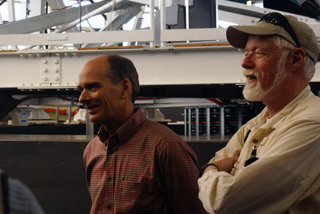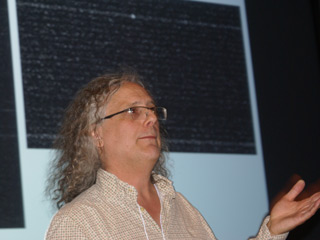Upgraded Telescope Ready to ‘Unlock the Mysteries of the Universe’
April 9, 2017
Astronomers and friends re-dedicated the giant telescope in a ceremony at McDonald Observatory

HET was upgraded to allow it to study dark energy, although its improved capabilities can be used to search for planets in other star systems, determine the composition of those planets’ atmospheres, and conduct other leading astronomical research.
The upgrade included replacing the tracking system at the top of the telescope, which allows HET to follow astronomical objects as Earth rotates on its axis. The new tracker allows astronomers to use about 10 meters of the telescope’s 11-meter (433-inch) primary mirror, compared to only about 9.2 meters before the upgrade. A new set of optics has expanded the telescope’s field of view to cover about 70 percent of the area of the full Moon, which allows it to monitor more targets in a single observation.
In addition, astronomers have installed or are completing “a killer combination of instruments” for HET, said Larry Ramsey, an astronomer at Penn State and chair of the HET board of directors. The most obvious is VIRUS, a set of 156 spectrographs that’s being installed on large scaffold-like structures attached to the sides of the telescope. Combined, the VIRUS units will have 35,000 optical fibers to carry light from the telescope to the spectrographs.
For HETDEX, astronomers will aim the telescope at a region of the northern sky near the Big Dipper in search of a specific type of galaxy. If a galaxy happens to align with one of the fibers, its light will be carried to a spectrograph for analysis.

So far, astronomers have installed 16 VIRUS units on the telescope, (each unit has two spectrographs, for a total of 32), and they’re already taking data, said HETDEX scientist Karl Gebhardt. “The data that’s coming out of the telescope now is fantastic,” he told attendees. “We’re on spec.”
Gebhardt, who is also one HETDEX’s founders, said that astronomers can follow-up on the VIRUS discoveries with another of the telescope’s new instruments, the Low-Resolution Spectrograph, which provides a more detailed look at each target. Early comparisons show a good match between the two instruments, Gebhardt said.
The High-Resolution Spectrograph, which will provide a much more detailed look at bright stars, galaxies, and other objects, is scheduled for installation on the telescope in the next few months. And the Habitable Planet Finder, which look for habitable worlds around the cool, faint stars known as M dwarfs, will follow in the fall.
HET was shut down for the upgrades in 2013. It returned to service in 2015, when the improved telescope took its first look at the sky. Scientists and engineers have been fine-tuning the new systems while they install the new instruments and begin taking data for HETDEX and other projects.
“It’s a crazy, exciting time now,” said Gebhardt. “We have to work really hard, but this is the fun time.”
